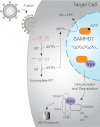The restriction factors of human immunodeficiency virus
- PMID: 23043100
- PMCID: PMC3510791
- DOI: 10.1074/jbc.R112.416925
The restriction factors of human immunodeficiency virus
Abstract
Cellular proteins called "restriction factors" can serve as powerful blockades to HIV replication, but the virus possesses elaborate strategies to circumvent these barriers. First, we discuss general hallmarks of a restriction factor. Second, we review how the viral Vif protein protects the viral genome from lethal levels of cDNA deamination by promoting APOBEC3 protein degradation; how the viral Vpu, Env, and Nef proteins facilitate internalization and degradation of the virus-tethering protein BST-2/tetherin; and how the viral Vpx protein prevents the premature termination of reverse transcription by degrading the dNTPase SAMHD1. These HIV restriction and counter-restriction mechanisms suggest strategies for new therapeutic interventions.
Figures




References
-
- Rahm N., Telenti A. (2012) The role of tripartite motif family members in mediating susceptibility to HIV-1 infection. Curr. Opin. HIV AIDS 7, 180–186 - PubMed
-
- Strebel K., Daugherty D., Clouse K., Cohen D., Folks T., Martin M. A. (1987) The HIV A (sor) gene product is essential for virus infectivity. Nature 328, 728–730 - PubMed
-
- Simon J. H., Gaddis N. C., Fouchier R. A., Malim M. H. (1998) Evidence for a newly discovered cellular anti-HIV-1 phenotype. Nat. Med. 4, 1397–1400 - PubMed
-
- Sheehy A. M., Gaddis N. C., Choi J. D., Malim M. H. (2002) Isolation of a human gene that inhibits HIV-1 infection and is suppressed by the viral Vif protein. Nature 418, 646–650 - PubMed
Publication types
MeSH terms
Substances
Grants and funding
LinkOut - more resources
Full Text Sources
Other Literature Sources
Miscellaneous

